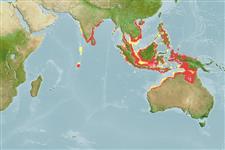>
Eupercaria/misc (Various families in series Eupercaria) >
Sillaginidae (Smelt-whitings)
Etymology: Sillago: From a locality in Australia.
Environment: milieu / Zona climática / intervalo de profundidade / distribution range
Ecologia
marinhas demersal; não migratória; intervalo de profundidade 0 - 60 m (Ref. 6205), usually 0 - 60 m (Ref. 6205). Tropical; 20°N - 23°S, 70°E - 143°E (Ref. 6205)
Indo-West Pacific: India and Sri Lanka; northern Australia from Exmouth Gulf, Western Australia to the Arafura Sea (Ref. 9819) and the Gulf of Carpentaria. Sillago lutea may be confused with Sillago sihama and Sillago japonica.
Comprimento de primeira maturação / Tamanho / Peso / Idade
Maturidade: Lm 11.2, range 10 - 12 cm
Max length : 16.0 cm SL macho/indeterminado; (Ref. 6205); common length : 15.0 cm SL macho/indeterminado; (Ref. 9679)
Espinhos dorsais (total) : 12; Raios dorsais (total) : 20 - 22; Espinhos anais: 2; Raios anais : 21 - 23; Vértebras: 33 - 35. Swim bladder with a median anterior extension and with or without rudimentary anteriorly directed anterolateral projections; posterior extension single. Body is light sandy brown above, pale brown to whitish below, with an ill defined silvery mid-lateral band; margins of scales may be slightly darker giving a vague meshwork pattern to the body above the lateral line; fins hyaline, the first dorsal-fin membrane tipped with a fine dusting of black; no dark spot at the base of the pectoral fin.
Body shape (shape guide): elongated; Cross section: circular.
Commonly associated with Penaeus merguiensis de Man in northern Australia, and occurs most abundantly on muddy or very silty substrates. Oviparous (Ref. 205). Sexually mature at 10 cm SL (ripe females 10.4-12.0 cm). This species could form the basis of a small by-catch fishery, to be exported ungutted (Ref. 6205).
Ciclo de vida ou comportamento de acasalamento
Maturidade | Reprodução | Desova | Ovos | Fecundidade | Larvas
McKay, R.J., 1992. FAO Species Catalogue. Vol. 14. Sillaginid fishes of the world (family Sillaginidae). An annotated and illustrated catalogue of the sillago, smelt or Indo-Pacific whiting species known to date. Rome: FAO. FAO Fish. Synop. 125(14):87p. (Ref. 6205)
Status na Lista Vermelha da UICN (Ref. 130435: Version 2025-1)
Ameaça para os humanos
Harmless
Uso pelos humanos
Pescarias: de interesse potencial
Ferramentas
Relatórios especiais
Baixar XML
Fontes da internet
Estimates based on models
Preferred temperature (Ref.
123201): 26.7 - 29, mean 28.1 °C (based on 1778 cells).
Índice de diversidade filogenética (Ref.
82804): PD
50 = 0.5000 [Uniqueness, from 0.5 = low to 2.0 = high].
Bayesian length-weight: a=0.00575 (0.00271 - 0.01223), b=3.06 (2.88 - 3.24), in cm total length, based on LWR estimates for this Genus-body shape (Ref.
93245).
Nível Trófico (Ref.
69278): 3.2 ±0.4 se; based on size and trophs of closest relatives
Resiliência (Ref.
120179): Elevada, tempo mínimo de duplicação da população menor que 15 meses (Preliminary K or Fecundity.).
Fishing Vulnerability (Ref.
59153): Low vulnerability (10 of 100).
🛈
